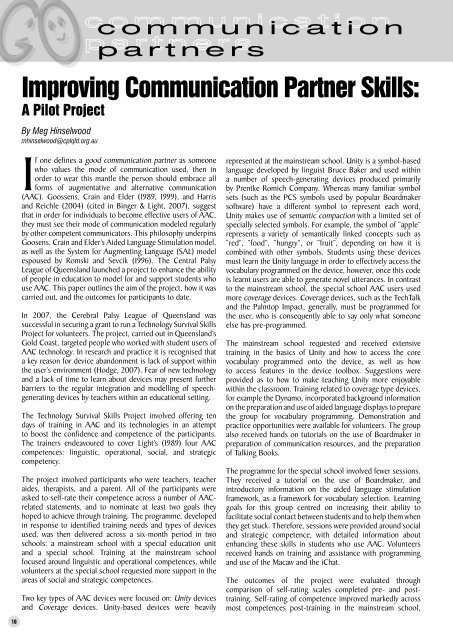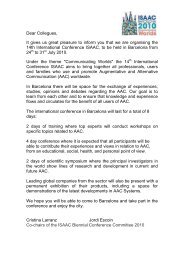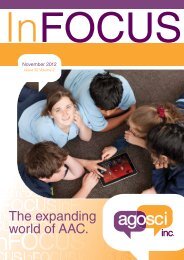May 2008 Edition - agosci
May 2008 Edition - agosci
May 2008 Edition - agosci
You also want an ePaper? Increase the reach of your titles
YUMPU automatically turns print PDFs into web optimized ePapers that Google loves.
Improving Communication Partner Skills:A Pilot ProjectBy Meg Hinselwoodmhinselwood@cplqld.org.auccommunicationo m m u n i c a t i o nppartnersa r t n e r sIf one defines a good communication partner as someonewho values the mode of communication used, then inorder to wear this mantle the person should embrace allforms of augmentative and alternative communication(AAC). Goossens, Crain and Elder (1989, 1999), and Harrisand Reichle (2004) (cited in Binger & Light, 2007), suggestthat in order for individuals to become effective users of AAC,they must see their mode of communication modeled regularlyby other competent communicators. This philosophy underpinsGoosens, Crain and Elder’s Aided Language Stimulation model,as well as the System for Augmenting Language (SAL) modelespoused by Romski and Sevcik (1996). The Central PalsyLeague of Queensland launched a project to enhance the abilityof people in education to model for and support students whouse AAC. This paper outlines the aim of the project, how it wascarried out, and the outcomes for participants to date.In 2007, the Cerebral Palsy League of Queensland wassuccessful in securing a grant to run a Technology Survival SkillsProject for volunteers. The project, carried out in Queensland’sGold Coast, targeted people who worked with student users ofAAC technology. In research and practice it is recognised thata key reason for device abandonment is lack of support withinthe user’s environment (Hodge, 2007). Fear of new technologyand a lack of time to learn about devices may present furtherbarriers to the regular integration and modelling of speechgeneratingdevices by teachers within an educational setting.The Technology Survival Skills Project involved offering tendays of training in AAC and its technologies in an attemptto boost the confidence and competence of the participants.The trainers endeavoured to cover Light’s (1989) four AACcompetences: linguistic, operational, social, and strategiccompetency.The project involved participants who were teachers, teacheraides, therapists, and a parent. All of the participants wereasked to self-rate their competence across a number of AACrelatedstatements, and to nominate at least two goals theyhoped to achieve through training. The programme, developedin response to identified training needs and types of devicesused, was then delivered across a six-month period in twoschools: a mainstream school with a special education unitand a special school. Training at the mainstream schoolfocused around linguistic and operational competences, whilevolunteers at the special school requested more support in theareas of social and strategic competences.Two key types of AAC devices were focused on: Unity devicesand Coverage devices. Unity-based devices were heavilyrepresented at the mainstream school. Unity is a symbol-basedlanguage developed by linguist Bruce Baker and used withina number of speech-generating devices produced primarilyby Prentke Romich Company. Whereas many familiar symbolsets (such as the PCS symbols used by popular Boardmakersoftware) have a different symbol to represent each word,Unity makes use of semantic compaction with a limited set ofspecially selected symbols. For example, the symbol of “apple”represents a variety of semantically linked concepts such as“red”, “food”, “hungry”, or “fruit”, depending on how it iscombined with other symbols. Students using these devicesmust learn the Unity language in order to effectively access thevocabulary programmed on the device, however, once this codeis learnt users are able to generate novel utterances. In contrastto the mainstream school, the special school AAC users usedmore coverage devices. Coverage devices, such as the TechTalkand the Palmtop Impact, generally, must be programmed forthe user, who is consequently able to say only what someoneelse has pre-programmed.The mainstream school requested and received extensivetraining in the basics of Unity and how to access the corevocabulary programmed onto the device, as well as howto access features in the device toolbox. Suggestions wereprovided as to how to make teaching Unity more enjoyablewithin the classroom. Training related to coverage type devices,for example the Dynamo, incorporated background informationon the preparation and use of aided language displays to preparethe group for vocabulary programming. Demonstration andpractice opportunities were available for volunteers. The groupalso received hands on tutorials on the use of Boardmaker inpreparation of communication resources, and the preparationof Talking Books.The programme for the special school involved fewer sessions.They received a tutorial on the use of Boardmaker, andintroductory information on the aided language stimulationframework, as a framework for vocabulary selection. Learninggoals for this group centred on increasing their ability tofacilitate social contact between students and to help them whenthey get stuck. Therefore, sessions were provided around socialand strategic competence, with detailed information aboutenhancing these skills in students who use AAC. Volunteersreceived hands on training and assistance with programmingand use of the Macaw and the iChat.The outcomes of the project were evaluated throughcomparison of self-rating scales completed pre- and posttraining.Self-rating of competence improved markedly acrossmost competences post-training in the mainstream school,16





